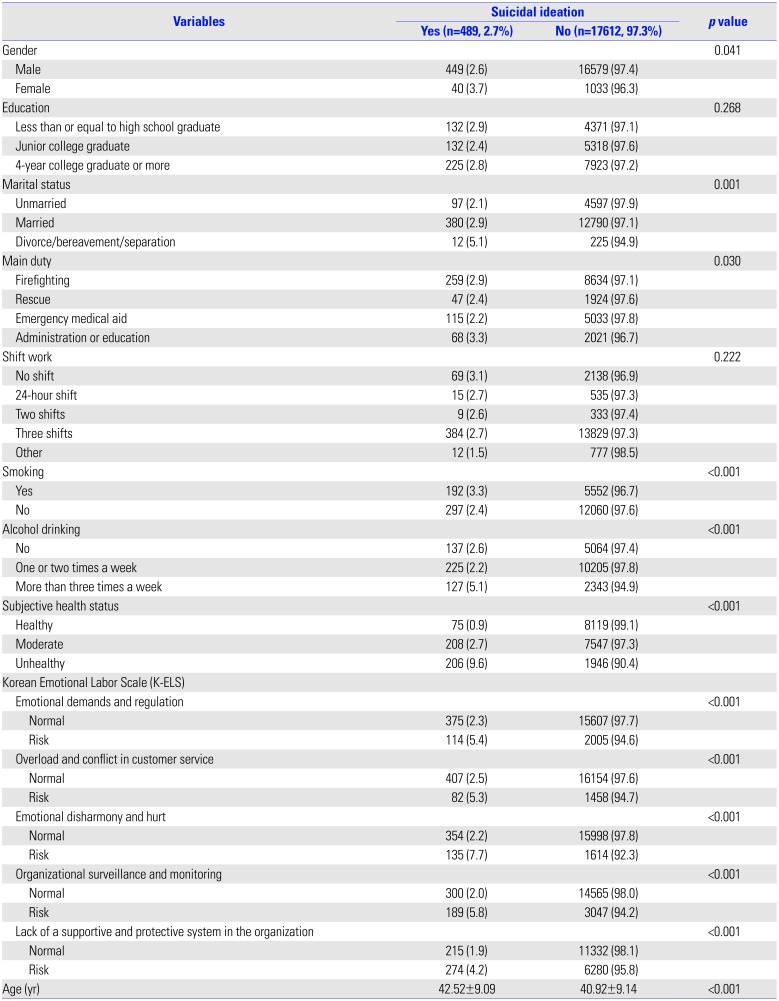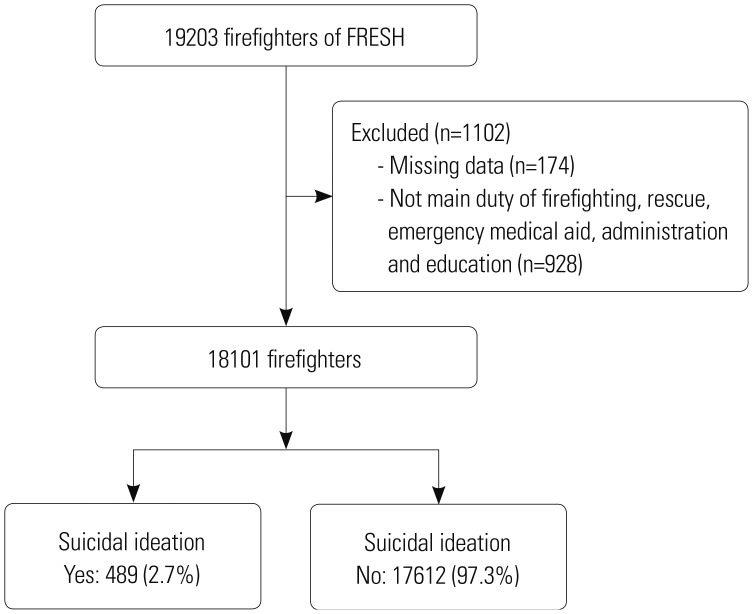1. Wharton AS. The affective consequences of service work: managing emotions on the job. Work Occup. 1993; 20:205–232.
2. Kim HJ, Choo J. Emotional labor: links to depression and work-related musculoskeletal disorders in call center workers. Workplace Health Saf. 2017; 65:346–354. PMID:
27895237.

3. Hochschild AR. The managed heart: commercialization of human feeling. Berkeley (CA): University of California Press;2012.
4. Kim GH, Lee HS, Jung SW, Lee JG, Lee JH, Lee KJ, et al. Emotional labor, workplace violence, and depressive symptoms in female bank employees: a questionnaire survey using the K-ELS and K-WVS. Ann Occup Environ Med. 2018; 30:17. PMID:
29564140.

5. Jeung DY, Lee HO, Chung WG, Yoon JH, Koh SB, Back CY, et al. Association of emotional labor, self-efficacy, and type A personality with burnout in Korean dental hygienists. J Korean Med Sci. 2017; 32:1423–1430. PMID:
28776336.

6. Grandey AA. When “the show must go on”: surface acting and deep acting as determinants of emotional exhaustion and peer-rated service delivery. Acad Manage J. 2003; 46:86–96.

7. Kim SY, Chang SJ, Kim HR, Roh JH. A study on the relationship between emotional labor and depressive symptoms among Korean industrial service employees. Korean J Occup Environ Med. 2002; 14:227–235.

8. Galán F, Ríos-Santos JV, Polo J, Rios-Carrasco B, Bullón P. Burnout, depression and suicidal ideation in dental students. Med Oral Patol Oral Cir Bucal. 2014; 19:e206–e211. PMID:
24121916.
9. Dyrbye LN, Thomas MR, Massie FS, Power DV, Eacker A, Harper W, et al. Burnout and suicidal ideation among U.S. medical students. Ann Intern Med. 2008; 149:334–341. PMID:
18765703.

10. Cavanagh JT, Carson AJ, Sharpe M, Lawrie SM. Psychological autopsy studies of suicide: a systematic review. Psychol Med. 2003; 33:395–405. PMID:
12701661.

12. World Health Organization. Preventing suicide: a global imperative. Geneva: World Health Organization;2014.
13. Ministry of Health and Welfare, Korea Suicide Prevention Center. 2018 Suicide prevention white book. Seoul: Korea Suicide Prevention Center;2019.
14. Han SG, Park CS, Jeong YK, Chang HJ, Kim NR. The study of Korean Occupational Index (2012). Seoul: Korea Research Institute for Vocational Education & Training;2012.
15. Chang SJ, Kang HT, Kim SY, Kim IA, Kim JI, Kim HR, et al. Application study of Korean Emotional Labor Scale and Korean Workplace Violence Scale. Ulsan: Occupational Safety and Health Research Institute;2014.
16. Warner P. Poisson regression. J Fam Plann Reprod Health Care. 2015; 41:223–224. PMID:
26106106.

17. Joo KS. A study on emotional labor and organizational commitment among firefighters in Korea. Crisisonomy. 2017; 13:45–54.

18. Cho S, Ryu SI, Lee MK. A study on emotional labor and job satisfaction among firefighters in Korea. Crisisonomy. 2017; 13:153–160.

19. Park CS, Kim JK. The influence of emotional labor at Seoul Management Operations Center on job performance: focusing on the mediating effect of social support. J Korea Saf Manag Sci. 2015; 17:13–25.
20. Kim YJ, Kim JH, Shim GS. The relationship among job stress, emotional labor, resilience and mental health in firefighters. J Korea Converg Soc. 2017; 8:379–389.
21. Ji DH, Choi MS. The comparative study on changes in turnover intention according to the level of burn out and the convergence mediating factors in fire officer. J Korea Soc Computer Inf. 2016; 21:111–117.

22. Smith TD, Hughes K, DeJoy DM, Dyal MA. Assessment of relationships between work stress, work-family conflict, burnout and firefighter safety behavior outcomes. Saf Sci. 2018; 103:287–292.

23. Katsavouni F, Bebetsos E, Malliou P, Beneka A. The relationship between burnout, PTSD symptoms and injuries in firefighters. Occup Med (Lond). 2016; 66:32–37. PMID:
26409054.

24. Boffa JW, Stanley IH, Smith LJ, Mathes BM, Tran JK, Buser SJ, et al. Posttraumatic stress disorder symptoms and suicide risk in male firefighters: the mediating role of anxiety sensitivity. J Nerv Ment Dis. 2018; 206:179–186. PMID:
29309295.
25. Ashforth BE, Humphrey RH. Emotional labor in service roles: the influence of identity. Acad Manage Rev. 1993; 18:88–115.

26. Kim WB, Rhee KY, Lee GR. Work environment and stress of emotional laborers. Korean J Sociol. 2012; 46:123–149.
27. Smith MJ, Carayon P, Sanders KJ, Lim SY, Legrande D. Employee stress and health complaints in jobs with and without electronic performance monitoring. Appl Ergon. 1992; 23:17–27. PMID:
15676845.

28. Choi SW. Cultural orientation of emotional labor in administrative service organizations: the case of national tax officials. Korean Public Adm Rev. 2012; 46:79–101.
29. Meier KJ, Mastracci SH, Wilson K. Gender and emotional labor in public organizations: an empirical examination of the link to performance. Public Adm Rev. 2006; 66:899–909.

30. Kim SG. An exploratory study on the emotional labor in public sector: focused on street-level bureaucrats in the civil service system. Korean J Local Gov Stud. 2009; 13:51–70.
31. Diefendorff JM, Richard EM, Yang J. Linking emotion regulation strategies to affective events and negative emotions at work. J Vocat Behav. 2008; 73:498–508.

32. Hobfoll SE, Freedy J. Conservation of resources: a general stress theory applied to burnout. In : Schaufeli WB, Maslach C, Marek T, editors. Professional burnout: recent developments in theory and research. Washington DC: Taylor & Francis;1993. p. 115–129.
33. Baumeister RF, Vohs KD, Tice DM. The strength model of self-control. Curr Dir Psychol Sci. 2007; 16:351–355.

34. Yoon SL, Kim JH. Job-related stress, emotional labor, and depressive symptoms among Korean nurses. J Nurs Scholarsh. 2013; 45:169–176. PMID:
23470274.

35. Brotheridge CM, Grandey AA. Emotional labor and burnout: comparing two perspectives of “people work”. J Vocat Behav. 2002; 60:17–39.

36. Yagil D. The mediating role of engagement and burnout in the relationship between employees' emotion regulation strategies and customer outcomes. Eur J Work Organ Psychol. 2012; 21:150–168.

37. Grandey AA, Fisk GM, Steiner DD. Must “service with a smile” be stressful? The moderating role of personal control for American and French employees. J Appl Psychol. 2005; 90:893–904. PMID:
16162062.

38. Dunnette MD, Hough LM. Handbook of industrial and organizational psychology, Vol. 3. 2nd ed. Palo Alto (CA): Consulting Psychologists Press;1992.
39. Kim MS, Kang JW, Han SS. Emotional labor and work life satisfaction of department store workers: mediating effect of job oppression. J Korean Soc Occup Environ Hyg. 2019; 29:420–429.






 PDF
PDF ePub
ePub Citation
Citation Print
Print




 XML Download
XML Download